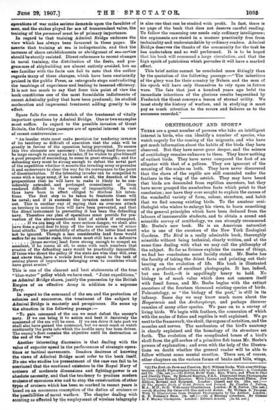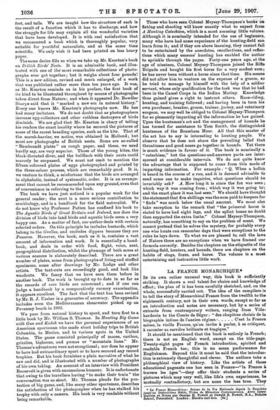ORNITHOLOGY AND SPORT.*
THERE are a great number of persons who take an intelligent interest in birds, who can identify a number of species, who watch eagerly for the coming of the migrants, and who have got much information about the habits of the birds they have observed. But they have never gone deeper, and the science of ornithology remains unknown to them. They know nothing of extinct birds. They have never compared the foot of an alligator with that of a pelican. They are ignorant of the meaning of the scales on both. They have never discovered that the claws of the reptile are still concealed under the feathers in the wing of the ostrich. They may have heard that birds are descended from reptilian ancestors, but they have never grasped the numberless facts which point to that conclusion ; nor have they ever sought to explain the causes of the wonderful variety of form, colour, structure, and habit that we find among existing birds. To the amateur orni- thologist who wishes to enlarge his views, to learn something of the general principles which have been deduced from the labours of innumerable students, and to obtain a sound and scientific survey of ornithology, we can strongly recommend Mr. Beebe's new Look. He is an American naturalist who is one of the curators of the New York Zoological Gardens. The Bird is a really admirable book, thoroughly scientific without being technical, clearly written, and at the same time dealing with what we may call the philosophy of the subject. So far as Science explains the causes of things, we find her conclusions most lucidly stated. Mr. Beebe has the faculty of taking the driest facts and pointing out their bearing on the evolution of life. His book is illustrated with a profusion of excellent photographs. It has, indeed, but one fault,—it is appallingly heavy to hold. No biology is of much value which does not concern itself with fossil forms, and Mr. Beebe begins with the extinct ancestors of the fourteen thousand existing species of birds. Paleontology, or "the biology of the past," is still in its infancy. Some day we may know much more about the Hesperornis and the Arehxoptenin, and perhaps discover remains of many other species. We pass on to a survey of living birds. We begin with feathers, the connexion of which with the scales of fishes and reptiles is well explained. We go next to the framework, the skull, the organs of nutrition, and the muscles and nerves. The mechanism of the bird's anatomy is clearly explained and the homology of its structure set forth. The evolution of the complicated bones of a bird's skull from the gill-arches of a primitive fish taxes Mr. Beebe's powers of explanation; and even with the help of the illustra- tions we doubt whether the general reader will be able to follow without some mental exertion. There are, of course, other chapters on the vadous forms of beaks and bills, wings, • (i) Ter nerd its Form and notation. By C. William Beebe. With orer370 Untie., chiefly Photographed from Life by the Author. London: A. Constable and Co. [14s. net.)---fll Selfish Birds' Nest.: How, Whore, and When to And and familia Tham. By If idaard Kauton, F.Z.S. Illustrated from Photographs by Cherry and Richard Reartou. With Coloured and Rembrandt Plates, New Edition, Bevteed end Enlarged. London aumell and Co. (Sls. IS) Tke!_,Aalaala Birds o/ Croat Britain and Zroland. By Charles J. Patteo,
M.A., X.110., Se.D. With many Illustrations. tendon H. Porter. [Sic. neLl
Hennas Lap Gem. vita Oen and wIth Kodak. By William S. Thomas. With 70 Illustrations from Original Photographs by the Author. London G. P. Puttiam'a Sens. LOs. net.]—(5) A Hennas Catochtma. By Colsetel B. F. Ideysey.Thompson. Loudon Edward Arnold. [3e. Gd. net.]
feet, and tails. We are taught how the structure of each is the result of a function which it has to discharge, and how the struggle for life may explain all the wonderful varieties that have been developed. It is with real satisfaction that we recommend a book which is thoroughly popular, very suitable for youthful naturalists, and at the same time scientific. We only wish it had been printed on less heavy paper.
The same desire fills us when we take up Mr. Kearton's book on British Birds' Nests. It is an admirable book, and Ulna-
tinted with one of the' most remarkable collections of photo.
graphs ever got together; but it weighs about four pounds! This is a new edition, revised and much enlarged, of a work that was published rather more than ten years ago. It was, as Mr. Kearton reminds us in his preface, the first book of its kind to be illustrated throughout by means of photographs taken direct from Nature; and when it appeared Dr. Bowater Sharpe said that it "marked a new era in natural history." Every one knows Mr. Kearton's photographs now. He has had many imitators. We do not doubt that as photographers increase egg-collectors and other ruthless destroyers of birds diminish. We are glad that Mr. Kearton is chary of telling his readers the exact locality where he secured the pictures of some of the rarest breeding species, such as the kite. That of the marsh-harrier, we notice, was obtained in Holland ; but most are photographs of British nests. Some are so-called " Rembrandt plates" on rough paper, and these, we need hardly say, are very superior. Those of the young kites, the black-throated diver, and the bullfinch with their nests could scarcely be surpassed. We must not omit to mention the fifteen coloured plates of eggs photographed and printed by the three-colour process, which are 'remarkably good. It is, we venture to think, a misfortune that the birds are arranged in alphabetic, instead of systematic, order. It is an arrange- ment that cannot be recommended upon any ground, even that of convenience in referring to the book.
The book we have just noticed is a popular work for the general reader ; the next is a more serious contribution to ornithology, and is a handbook for the field naturalist. We
do not know why Professor Patten has confined his book to The Aquatic Birds of Great Britain and Ireland, nor does the
division of birds into land birds and aquatic birds seem a very happy one. As a matter of fact, our author deals with certain selected orders. On this principle he includes bustards, which
belong to the Grallae, and excludes dippers because they are Passeres. However, the book, such as it is, contains a vast amount of information and work. It is essentially a hand-
book, and deals in order with food, flight, voice, nest, geographical distribution, whilst the plumage of both sexes at various seasons is elaborately described. There are a great number of plates, some from photographs of living and stuffed specimens, some after drawings by Mr. Lodge and other artists. The text-cuts are exceedingly good, and look like woodcuts. We fancy that we have seen them before in another book. The work is brought up to date in so far as the records of rare birds are concerned ; and if one can judge a handbook by a comparatively cursory examination, it appears excellent. The fact that the text has been revised by Mr. R. T. Useher is a guarantee of accuracy. The appendix includes even the Mediterranean shearwater picked up on Pevensey beach in 1906.
We pass from natural history to sport, and turn first to a little book by Mr. William S. Thomas. In Hunting Big Game with Gun and Kodak we have the personal experiences of an
American sportsman who made short holiday tips to British Columbia, to Mexico, and to various spots in the United States The game consisted principally of moose, caribou,
grizzlies, bighorns, and pumas or "mountain lions." Mr. Thomas's adventures were not exceptional ; nor does he appear
to have had extraordinary sport or to have secured any record trophies. But his book furnishes a plain narrative of what he saw and did, and is illustrated with a number of photographs of his own taking. An account of an interview with President Roosevelt is given with unconscious humour. It is unfortunate that owing to the travellers having "to make their train" the conversation was so short. Mr. Thomas pleads for the pro- tection of big game, and, like many other sportsmen, describes the satisfaction of the photographer when he has stalked his trophy with only a camera. His book is very readable without being remarkable.
Those who have seen Colonel Meyeey-Thompson's books on fishing and shooting will know exactly what to expect from A Hunting Catechism, which is a most amusing little volume. Although it is nominally intended for the use of beginners, many who have had some experience of the bunting-field can learn from it; and if they are above learning, they cannot fail to be entertained by the anecdotes, recollections, and reflec- tions which many seasons' hunting has enabled the author to sprinkle through the pages. Forty-one years ago, at the age of nineteen, Colonel Meysey-Thompson joined the Rifle Brigade and bought his first horse for a very modest sum; he has never been without a horse since that time. His means did not allow him to venture on the expense of a groom, so be tried to manage by himself with the help of a soldier serVant, whose only qualification for the task was that he had been in the Camel Corps in the Indian Mutiny. Knowledge thus gained' gives a right to instruct others. Race-riding., hunting, and training followed ; and having been in turn his own purchaser, breaker, groom, trainer, jockey, and veterinary surgeon, we may well be obliged to Colonel Meysey-Thompson for so pleasantly imparting all the information he has gained. Upon the huntsman's art and the management of hounds hi has turned for assistance to Tom Smith, the distinguished huntsman of the Brambam Moor. All that this master of the art has to say is interesting to hunting people. We observe that he does not share the prevailing belief that throatiness and good noses go together in hounds. Yet there is much evidence in favour of it. The book is nominally' " catechism," but the questions-and-answers parts are inter- spersed at considerable intervals. We do not quite know the advantage that is supposed to come from this 'mode of imparting information. For example : "Q. When a 1101101 is heard in the course of a run, and it is deemed advisable to send some one to make inquiries, what questions should be invariably ask ? A. How long it is since the fox was seen ; which way it was coming from ; which way it was going to; and the exact place it was last seen." We should have thought the statement that five shillings was the sum paid to keepers for "finds" was much below the usual amount. We must also take exception to the remark that "the primeval horse is stated to have bad eight legs, and the splint bones no doubt then supported the extra limbs." Colonel Meysey-Thompson, naturally, has something to say on the problem of scent. We cannot pretend that he solves the mystery, for probably every one who hunts can remember days that were exceptions to the rules be lays down. To what we are pleased to. call the laws of Nature there are no exceptions when we have framed our formula correctly. Besides the chapters on the etiquette of the hunting-field, hunters, and hounds, there are chapters on the habits of stags, foxes, and hares. The volume is a most entertaining and instructive little work.

















































 Previous page
Previous page